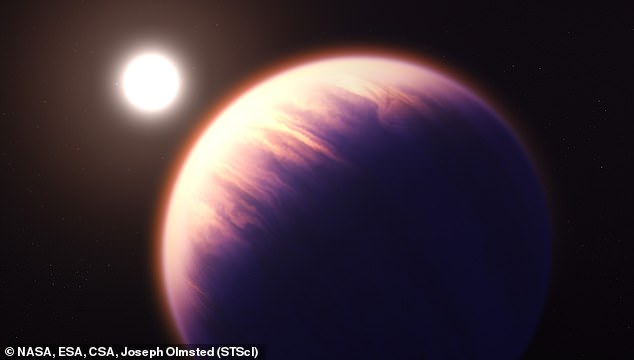Extraterrestrial life has yet to be found in space, but a new study has discovered “telltale” signs of an inhabited planet.
Researchers at the University of California, Riverside (UCR) have found that greenhouse gases, like those emitted on Earth, would mean that a distant world had been terraformed or artificially altered.
Signatures of methane, ethane and propane, along with gases composed of nitrogen and fluorine or sulfur and fluorine, could indicate life forms that use technology because the gases are only formed during manufacturing.
Scientists ran simulations on a hypothetical planet and found that NASA’s James Webb Space Telescope (JWST) could detect the gases as easily as it would ozone on Earth.
Extraterrestrial life has yet to be found in space, but a new study has discovered a ‘tell-tale’ signal from an inhabited planet
UCR astrobiologist and lead author of the study, Edward Schwieterman, said, “For us, these gases are bad because we don’t want to increase warming.”
“But they would be good for a civilization that might want to prevent an impending ice age or terraform an otherwise uninhabitable planet in its system, as humans have proposed for Mars.”
The five gases proposed by the researchers are used on Earth in industrial applications, such as the manufacturing of computer chips.
The researchers chose to simulate a planet in the TRAPPIST-1 system because it is home to seven known rock words and is one of the most studied planetary systems.
They used the Planetary Spectrum Generator (PSG), which is a model designed to synthesize and recover data about a planet’s atmosphere and surface.
The team simulated the five gases on the hypothetical planet and calculated how many observations JWST would need to detect them using its Mid-Infrared Instrument (MIRI), which detects wavelengths of 5 to 12 micrometers.
MIRI has a camera and a spectrograph, which separates the incoming light by its frequency and records the resulting spectrum.
MIRI also has sensitive detectors that allow it to see redshifted light from distant galaxies, newly formed stars and barely visible comets, as well as objects in the Kuiper Belt.
The study showed that JWST was able to detect greenhouse gases as easily as it would detect Earth’s ozone.

Researchers at the University of California, Riverside (UCR) found that greenhouse gases, like those emitted on Earth, would mean that a distant world would have been terraformed or artificially altered.

Scientists ran simulations on a hypothetical planet and found that JWST could detect the gases in just five flybys as easily as it could detect ozone on Earth.
And the system revealed that JWST detected gases with just five transits for concentrations as high as 100 parts per million (ppm).
Another advantage of searching for the proposed greenhouse gases is that they are exceptionally long-lived and would persist in an Earth-like atmosphere for up to 50,000 years.
“They wouldn’t need to be replenished too frequently to maintain a hospitable climate,” Schwieterman said.
Other members of the research team echoed Schwieterman’s enthusiasm for the potential of finding signs of intelligent life, but also for how much current technology has brought us closer to that goal.
Daniel Angerhausen of the Swiss Federal Institute of Technology said: ‘Our thought experiment shows how powerful our next-generation telescopes will be.
“We are the first generation in history to have the technology to systematically search for life and intelligence in our galactic neighborhood.”

